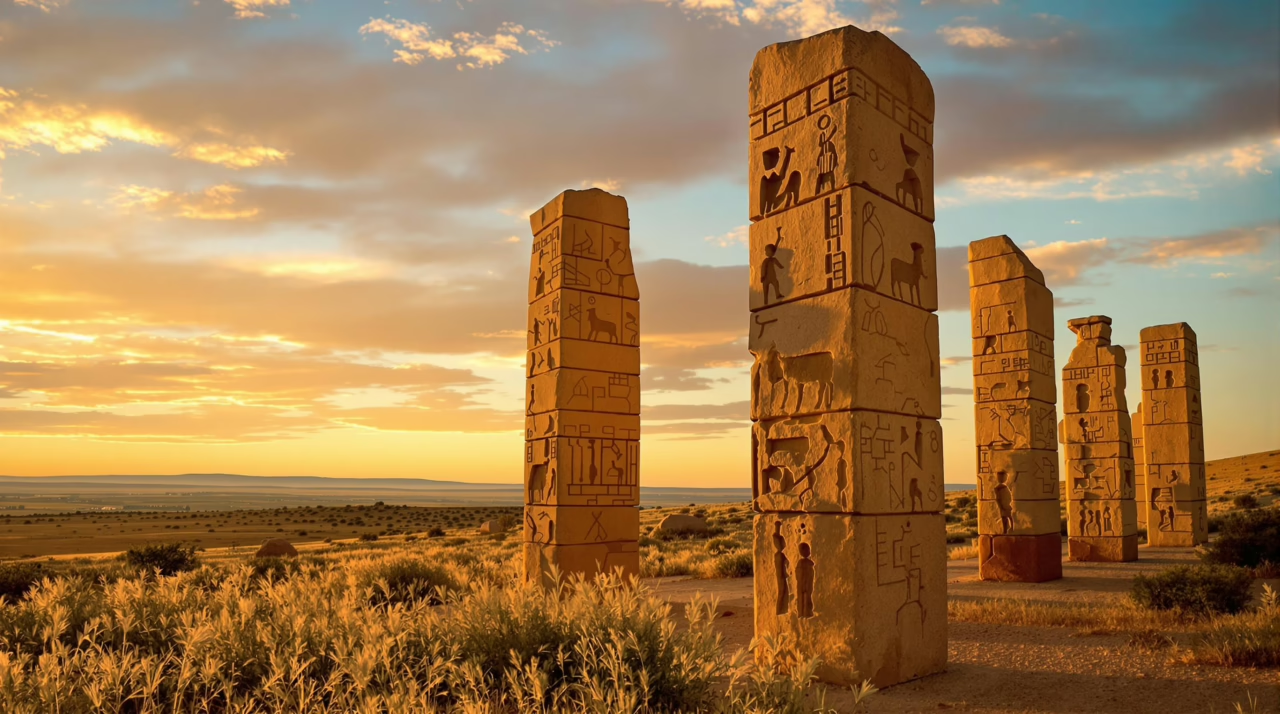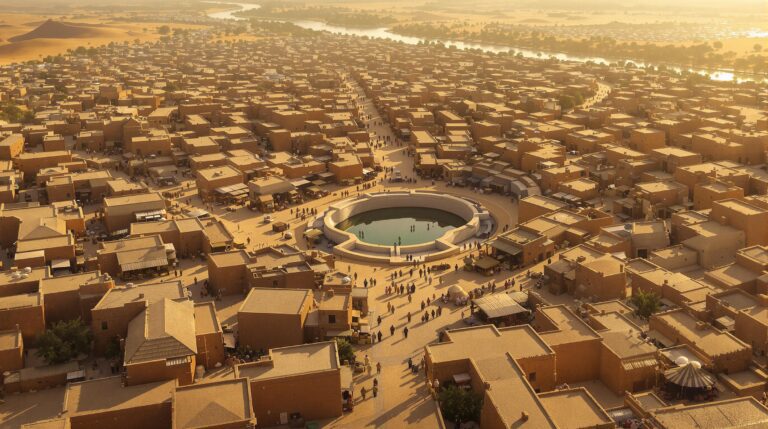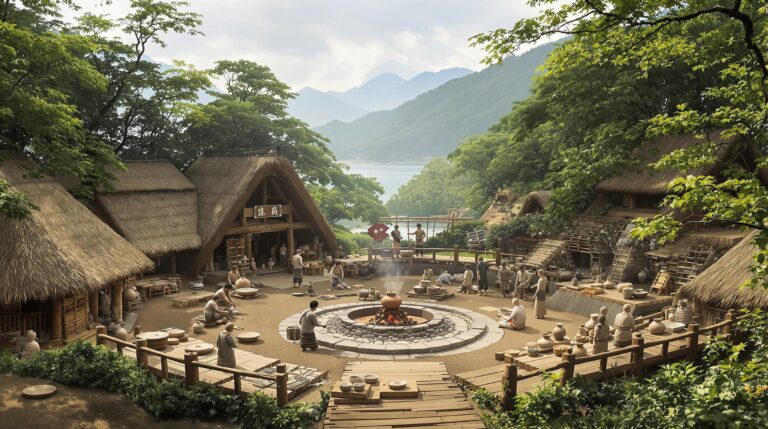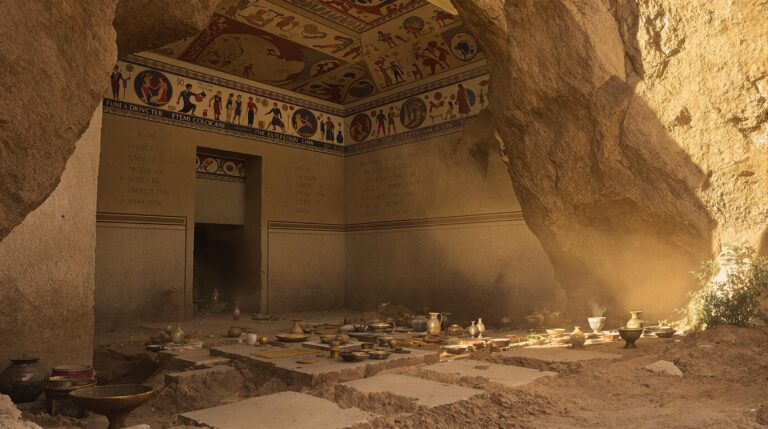Göbekli Tepe Mystery: Ancient Site Redefines History

Göbekli Tepe presents a fascinating conundrum in the study of early human civilization.
Its monumental structures and intricate carvings prompt questions about the social and religious dynamics of prehistoric societies.
What role did this site play in the lives of hunter-gatherers?
Did it influence the shift to agriculture? As researchers continue to uncover its secrets, the implications for our understanding of human history grow ever more profound.
What might these discoveries reveal about our collective past?
TL;DR
Hide- Göbekli Tepe, discovered in the 1990s, challenges established narratives about early human civilization and social organization.
- The site features intricate carvings and monumental T-shaped pillars, suggesting advanced artistic and architectural capabilities among hunter-gatherers.
- Ongoing research raises questions about the site's purpose, with theories linking it to communal rituals and shamanistic practices.
- Göbekli Tepe may predate agriculture, indicating that complex societal behaviors existed before agrarian lifestyles became dominant.
- Environmental threats, including climate change and pollution, pose significant challenges to the preservation of this historically significant site.
Göbekli Tepe: Uncovering the World’s Oldest Megalithic Site
The discovery of Göbekli Tepe has transformed our understanding of prehistoric societies and their architectural capabilities.
Scholars are intrigued by the circumstances surrounding its unearthing and the implications it holds for the timeline of human civilization.
What can the historical context of this remarkable site reveal about the people who constructed it and their cultural practices?
The Historical Context: When and How Göbekli Tepe Was Found
The discovery of Göbekli Tepe by Klaus Schmidt and his team marked a pivotal moment in archaeology, revealing a site that challenged established narratives about early human civilization.
Initial excavations unearthed intricate carvings and massive stone pillars, prompting a reevaluation of the social and religious practices of prehistoric societies.
How did this extraordinary find reshape our understanding of human history, and what were the reactions from the academic community and beyond?
The Discovery by Klaus Schmidt and Team
Unearthing the secrets of Göbekli Tepe began in the 1990s when Klaus Schmidt, a German archaeologist, recognized the site’s potential during a survey of southeastern Turkey.
His team’s discovery raised intriguing questions about early human civilization, including:
- The purpose of monumental structures
- The role of social organization in prehistoric times
- Insights into ancient belief systems
These findings continue to challenge historical narratives.
Earliest Excavations and Initial Reactions
Excavations at Göbekli Tepe commenced in earnest during the 1990s, igniting a wave of curiosity among archaeologists and historians alike.
Initial reactions ranged from excitement to skepticism, as the site’s monumental structures challenged established narratives of prehistoric human society.
The intricate carvings and massive stones prompted questions about societal organization, ritual practices, and the very origins of civilization itself, reshaping academic perspectives.
Göbekli Tepe’s Astonishing Architectural Elements
Göbekli Tepe features remarkable circular enclosures adorned with imposing T-shaped pillars, raising intriguing questions about their purpose and construction methods.
How did a society with limited technology manage to create such complex and monumental architecture?
The architectural elements invite further exploration into the cultural and engineering capabilities of its creators.
The Circular Enclosures and T-Shaped Pillars
Göbekli Tepe’s circular enclosures and T-shaped pillars showcase remarkable stonework that invites scrutiny.
The intricate carvings and animal depictions etched into these structures raise questions about their significance and the beliefs of their creators.
What might these artistic elements reveal about the social and spiritual life of a society that thrived over 12,000 years ago?
Intricacies of Stonework and Carvings
At the heart of archaeological intrigue lies the remarkable stonework and carvings of Göbekli Tepe, showcasing a level of craftsmanship that challenges conventional understanding of prehistoric societies.
- Intricate carvings suggest advanced artistic expression
- T-shaped pillars exhibit symbolic significance
- The circular enclosures reflect sophisticated architectural planning
These elements provoke inquiries into the cultural and social dynamics of the people who created them.
Animal Depictions and Their Possible Meanings
Animal depictions at Göbekli Tepe serve as a profound window into the beliefs and practices of its ancient builders.
These intricate carvings feature various creatures, suggesting a complex relationship between humans and animals. Scholars ponder whether these representations symbolize spiritual beliefs, hunting prowess, or social status.
Each image invites further exploration, revealing layers of meaning that challenge our understanding of early human societies.
Questions About Construction Methods
The construction methods employed by hunter-gatherers at Göbekli Tepe raise intriguing questions about their capabilities and resources.
How could these groups, traditionally seen as nomadic, orchestrate such monumental architecture?
Additionally, comparisons to other ancient sites may provide insights into the techniques and social organization necessary for creating these remarkable structures.
How Did Hunter-Gatherers Build Such Structures?
How could hunter-gatherers, traditionally viewed as nomadic and transient, have undertaken the monumental task of constructing Göbekli Tepe, a site rich with intricately carved pillars and vast enclosures?
- Advanced social organization and cooperation
- Knowledge of stone-working techniques
- Possible seasonal gatherings for construction
These factors invite further exploration into the ingenuity and capabilities of these early communities, challenging preconceived notions of their lifestyle.
Comparisons to Other Ancient Sites
While Göbekli Tepe stands out for its monumental pillars and enigmatic carvings, comparisons with other ancient sites reveal intriguing questions about construction methods and societal organization.
Sites like Stonehenge and the Pyramids prompt inquiry into resource allocation, workforce dynamics, and technological advancements.
How did these cultures, often deemed primitive, achieve such complex feats of architecture, and what does this imply about human potential?
Societal Implications: Ritual Center or Something Else?
The role of Göbekli Tepe as a potential ritual center raises intriguing questions about early human society.
Could the monumental site signify the emergence of organized labor and community collaboration, or might it serve a function beyond mere religious ceremonies?
Exploring these theories may reveal deeper insights into the social structures of prehistoric populations.
Theories on Religious Ceremonies
The enigmatic site of Göbekli Tepe raises intriguing questions about its potential functions in ancient society, especially concerning shamanistic practices and communal gatherings.
Could this monumental structure have served as a ritual center, facilitating spiritual experiences and social cohesion?
Alternatively, might it represent something more complex, such as a great gathering place for diverse groups to converge and share beliefs?
Potential Role of Shamanistic Practices
How might shamanistic practices have influenced the social and spiritual dynamics at Göbekli Tepe? Scholars propose intriguing theories regarding this ancient site’s purpose:
- Connection to the supernatural: Shamanic rituals may have facilitated communication with otherworldly forces.
- Community cohesion: Shared rituals could strengthen social bonds among diverse groups.
- Cultural transmission: Shamanism might have played a role in passing down traditions and knowledge.
These factors raise essential questions about the site’s significance.
The Great Gathering Place Hypothesis
While the exact purpose of Göbekli Tepe remains debated, the Great Gathering Place Hypothesis suggests that this monumental site served as a focal point for communal rituals and ceremonies.
This theory invites exploration of societal dynamics, questioning whether it facilitated social cohesion or religious expression.
Did it unite disparate groups, fostering a sense of identity, or perhaps serve other, less understood, communal functions?
Emergence of Organized Labor and Community
The construction of Göbekli Tepe raises intriguing questions about the emergence of organized labor and community in prehistoric societies.
Did the collaborative efforts required for such monumental architecture precede the advent of agriculture, suggesting a complex social structure?
This possibility invites further exploration into whether Göbekli Tepe served primarily as a ritual center or fulfilled additional societal functions.
Indications of Collaborative Effort
As researchers explore deeper into the enigma of Göbekli Tepe, evidence increasingly suggests that its construction was not merely an act of individual labor but rather a remarkable manifestation of collective effort.
This raises intriguing questions about societal organization, such as:
- Coordination of skilled labor
- Shared resources among communities
- Collective cultural or spiritual motivations
These factors indicate a sophisticated, interconnected society at an unprecedented time in human history.
Did Göbekli Tepe Precede Agriculture?
Although the exact timeline remains uncertain, many scholars ponder whether Göbekli Tepe predates the advent of agriculture.
This suggests that this monumental site may have served as a catalyst for societal transformation rather than merely a product of an agrarian lifestyle.
This raises intriguing questions about organized labor, the emergence of community, and the rituals that may have united early human societies in shared purpose.
Controversies and Ongoing Research
Controversies surrounding Göbekli Tepe continue to spark vigorous debate among scholars, particularly regarding its purpose and the implications of its findings.
The ongoing research efforts raise critical questions about how to balance preservation with modern archaeological practices.
As new discoveries emerge, the dialogue surrounding this ancient site remains dynamic and unresolved.
Disagreements in Scholarly Circles
Scholarly debates surrounding Göbekli Tepe highlight the complexities in interpreting its archaeological data.
Different researchers present varying theories on the site’s purpose and significance, often influenced by the advanced technologies employed in recent explorations.
As new findings emerge, the discourse continues to evolve, prompting questions about the implications for understanding human history.
Different Interpretations of Archaeological Data
As researchers explore deeper into the enigmatic site of Göbekli Tepe, a tapestry of differing interpretations emerges, revealing a complex landscape of archaeological data.
Key disagreements include:
- The site’s purpose: ritualistic vs. communal gathering
- The implications for social structure: egalitarian vs. hierarchical
- The timeline of construction: solitary efforts vs. collaborative endeavors
These debates highlight the dynamic nature of ongoing research and the search for understanding humanity’s ancient past.
New Technologies Used in Exploration
Emerging technologies have begun to reshape the landscape of archaeological exploration at Göbekli Tepe, prompting both excitement and contention among researchers.
Advanced methods, such as ground-penetrating radar and 3D modeling, reveal hidden structures but also ignite debates over data interpretation. Scholars grapple with differing opinions on the significance of findings, reflecting a broader struggle between tradition and innovation in understanding this ancient site.
Preservation Efforts in a Modern Era
As Göbekli Tepe faces increasing environmental threats, the urgency of effective preservation strategies becomes paramount.
The interplay between tourism development and heritage conservation raises critical questions about the balance between accessibility and protection of this ancient site.
Ongoing research seeks to address these challenges, prompting a reevaluation of current practices and their long-term implications.
Protecting Ancient Heritage from Environmental Threats
While the discovery of Göbekli Tepe has revolutionized understanding of ancient human societies, the site now faces significant environmental threats that challenge preservation efforts.
Key concerns include:
- Climate change impacting soil stability
- Increased vegetation growth leading to erosion
- Pollution from nearby agricultural practices
These factors raise questions about the long-term preservation of this extraordinary site, prompting ongoing research and debate among conservationists and archaeologists.
The Impact of Tourism and Development
The impact of tourism and development on Göbekli Tepe presents a complex dilemma for archaeologists and conservationists alike.
While increased visitor access promotes awareness and funding, it simultaneously risks damaging this irreplaceable site.
Ongoing research seeks to balance preservation with the economic benefits of tourism, raising questions about sustainable practices.
How can humanity safeguard its ancient heritage while embracing modern progress?
Why Göbekli Tepe Shifts Our Perspective on Human History
Göbekli Tepe challenges conventional narratives about the origins of civilization, prompting scholars to reconsider the established timeline of human development.
Its intricate structures suggest that complex societal behaviors emerged much earlier than previously thought.
What future discoveries at this site might reveal about early human culture remains an intriguing question for researchers and historians alike.
Rethinking the Timeline of Civilization
Göbekli Tepe challenges the conventional timeline of civilization by suggesting that monumental architecture may have emerged before the development of agriculture.
This intriguing possibility raises questions about the social structures and complexities of prehistoric communities.
How might the act of building such structures indicate a level of social organization previously unrecognized in early human history?
Could Monument Building Come Before Farming?
How could the construction of monumental structures like those at Göbekli Tepe precede the advent of agriculture? This intriguing question invites exploration into early human society.
Key considerations include:
- The potential for communal effort and social organization prior to farming.
- The role of ritual and symbolism in motivating large-scale projects.
- The implications for understanding human priorities and societal structures.
Such insights challenge conventional timelines of civilization.
Implications for Our Understanding of Social Complexity
As researchers explore the significance of monumental sites like Göbekli Tepe, they uncover profound implications for understanding social complexity in early human societies.
This site challenges the traditional view of civilization’s timeline, suggesting that sophisticated social structures and collective efforts predated agriculture.
Such findings invite a reevaluation of human organization, creativity, and the capacity for collaboration, reshaping our narrative of societal evolution.
Future Exploration and Potential Revelations
Future excavations at Göbekli Tepe hold the promise of uncovering new insights about this ancient site, yet many questions remain unanswered.
What secrets might the layers of sediment still conceal, and how could these findings reshape our understanding of early human society?
As researchers plan their next steps, the anticipation grows for revelations that could profoundly alter the narrative of human history.
Plans for Further Excavation
Exciting plans for further excavation at Göbekli Tepe promise to deepen our understanding of this ancient site, which has already transformed perspectives on human history.
Researchers aim to uncover:
- New structures that may reveal social dynamics of prehistoric societies
- Artifacts shedding light on early religious practices
- Insights into the shift from nomadic to settled lifestyles
These explorations could redefine humanity’s timeline and cultural evolution.
Unanswered Questions That Await Clarity
What secrets lie beneath the surface of Göbekli Tepe, waiting to be uncovered?
As researchers explore deeper, questions about its purpose, the society that constructed it, and the implications for human history emerge.
How did such advanced knowledge develop so early?
Future excavations may provide clarity, revealing connections between spirituality, architecture, and social organization that could redefine humanity’s narrative.
Wrapping Up
Göbekli Tepe stands as a monumental puzzle, its stone pillars symbolizing the weight of humanity’s quest for meaning long before agriculture took root.
This ancient site invites scholars to reconsider the foundations of civilization, suggesting that the human spirit’s yearning for connection and understanding transcended mere survival.
As researchers explore deeper into its mysteries, Göbekli Tepe challenges us to redefine not only our past but also the very essence of what it means to be human.





